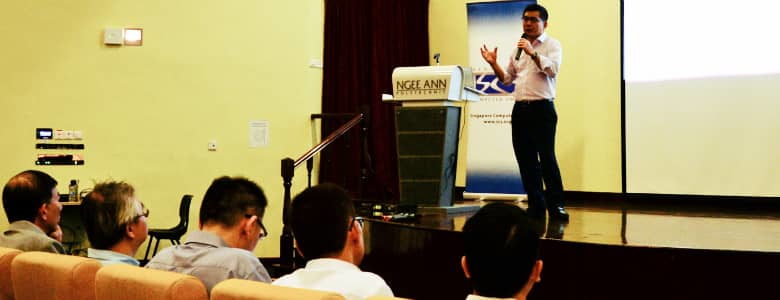Project: Digital citizen–customer

Imagine the complex task of attempting to integrate online licence application systems from more than 20 different government agencies into one enormous, all-encompassing beast.
It sounds like the modern equivalent of the Gordian Knot — all but impossible to solve, unless you are Alexander the Great.
“A project like that is bound to fail, and it did fail, spectacularly,” said Mr Chan Cheow Hoe, GovTech’s Deputy Chief Executive and Government Chief Information Officer, who was speaking on 19 April 2017 at the Singapore Computer Society’s Project Management Seminar.
Faced with advances in technology and changes in user demand, the government has had to rethink how it manages IT projects and delivers services to the public, said Mr Chan.
Customer paradigm shift
Not too long ago, government agencies were delivering IT services to the public in a manner that was very government-centric, noted Mr Chan.
“I realised that many people in government didn’t think of citizens as their customers, and that’s a huge problem,” he said. “If you don’t think of them in this way, you’re not going to be creating something that your most important stakeholder will want to consume.”
Today, part of what GovTech does is to help agencies be more citizen-centric, focusing on user experience and empathetic design for the customer, he said. “It’s now about what the customer wants, not what the government can do. The paradigm shift is tremendous.”
After trying and failing to create the “mother of all licensing systems”, the team in charge took a different tack, said Mr Chan. They left each individual agency’s system intact, but built a unified system of engagement on top of everything, which presented a common front end to the citizen user.
By starting with just a few agencies, the team was able to roll out a new system within several months, and then proceeded to add a few more agencies every month. “If you want to transform and move forward, you have to rethink how you do things.”
“You need to be able to maintain a combination of agile management and enterprise IT, which are two very different things.”
Uplifting capabilities
When Mr Chan first joined the public sector, he found that the government had almost no digital capabilities of its own. Instead, it outsourced technology projects to outside vendors.
“We were struggling with almost every project partly because our people went from being project managers to being contract managers,” he said. “As a result, they didn’t develop skills, which in this day and age are very important.”
The situation has since evolved. GovTech now houses a Government Digital Services (GDS) team of about 150 people with expertise in a variety of areas, including data science, user experience design, application infrastructure, geospatial applications and Internet of Things engineering.
“Capabilities are something we need to develop, and in some ways they spread like a virus,” said Mr Chan. “If you have capabilities, you uplift everybody who works with you.”
“If [vendors] work with a government like Singapore’s that is building capabilities, your people and products will get better, and chances are your company will succeed,” he added.
“I've been challenging our partners quite a fair bit. We're not going to be passive buyers, because the idea is to create a better product.”
Change is the only constant
Building capabilities involves more than just finding people who can code, said Mr Chan. The projects that GovTech takes on are invariably multidisciplinary in nature, and require an overlap of different skill sets within the ‘squad’ working on it.
These squads are not static — depending on the needs of the project, or even on the stage of the project, they can recombine to address different problems.
“I think the ability to be agile and to pivot is going to be very important for a new tech organisation to move forward in the future,” said Mr Chan. “Over time the diversity and richness of the skill base within the organisation will increase. We will then have the ability to challenge assumptions and come up with totally new products and services.”
Change will be the only constant for tech organisations of the future, and managing this will require constant communication with employees.
“Managing change is no longer just an event. It has become a lifestyle,” he said. “You need to be transparent and, as far as possible, let people know what will happen next; you should also admit to what you don't know. I think that attitude of openness is important in getting people to come together.”
He concluded: “We really need to look at project management very differently from before. I have nothing against traditional methods, but today we live in a different context, and our mindsets need to change in order for us to stay relevant and effective.”


